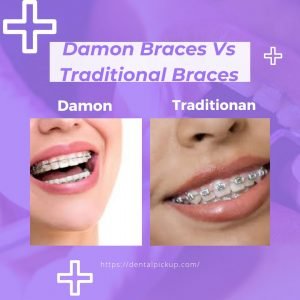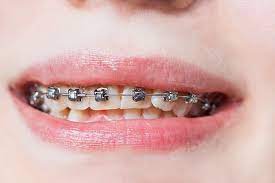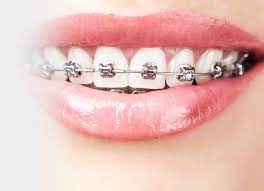
Traditional Braces
Traditionally, you might have seen the braces people use to treat their teeth’ defects. They just look similar to ‘train-tracks’ as they fix brackets on the teeth attached to a n arch wire to apply the required pressure. This traditional way of dealing with the teeth is medically known as conventional ligation.
Problem(s): You need to visit your dentist on a regular basis for the routine check ups throughout your treatment tenure. The other significant problem is due to the friction caused by the pressure applied, making the wearer uncomfortable with the braces at least for a week or two.
Damon Braces
Technology has brought innovation in almost every field of life since the past few decades. Damon braces are just one example. Damon was basically the name of the doctor who first proposed these braces back in 1996.
- Dr. Dwight Damon was critically concerned about the issue of friction that occurs during treatment with the traditional braces.
- These braces are specifically designed to meet the issue of friction at the cost of an increased time and prolonged discomfort.
- The way wire holds the brackets on your teeth creates the basic difference in the aforementioned types of braces.
- In traditional braces wire is attached on the brackets by using elastic bands whereas in Damon braces a unique sliding mechanism is used to make your teeth comfortable and moveable in the reduced friction environment.
Damon Vs Traditional: The Basic Differences
Both the braces are different in their way of working and its after effects as one type of braces cause friction while the other do not. Consider the following key points in this regard:
- The Friction Issue: On one hand, we have the traditional train-track like braces whereas on the other hand, we have somehow more advanced technological braces that can make your teeth more comfortable by eradicating friction.
- Using Elastic Bands: Traditional braces use elastic bands as a necessary element to tie up the arch wire with the teeth in order to apply pressure.
Problem: The use of elastic rubber further leads to the making of bacteria that can cause bacterial infection and gingivitis.
Damon braces are safer in this regard as they don’t need any elastic bands or rubber bands due to the different working mechanism.
Advantages of Damon Braces
Due to the advanced technology, damon braces are found to be more reliable and efficient in treating the issues like overcrowded teeth, overbiting, and straight alignment. The following are the advantages of using damon braces in comparison to that of traditional braces:
- Metal Braces: These braces are made up of metal and do not require any elastic bands for the teeths to move. This feature makes them less visible comparatively.
- Self-ligating: Unlike conventional or traditional braces, damon braces are self-ligating. As per the dentists these types of braces are more adaptable and comfortable for the patients.
- Gentle and Sensitive: Damon braces are perfect for the sensitive gum tissues due to their gental treatment of your teeth.
- Faster Treatment: The innovative metal braces are faster in bringing the desired results so that you can enjoy your dream smile.
- Lesser Plaque attraction: the absence of the elastic and rubber lessen the chances for the teeth to get plaque, as these braces are made up of metal that naturally attracts less plaque.
- Easy Cleaning: Damon braces are more easy to clean through brushing and flossing in comparison the traditional braces as they attract more plaque due to the presence of rubber and elastic bands.
Types of Damon Braces
Damon braces have different types depending upon their features, material, brand, and working mechanism. Following is the detailed discussion on the types of damon braces.
- Metal Braces: These braces are made up of metal that attracts less plaque making it more safer for the patient. These braces work on a sliding mechanism that reduces friction so that teeth can move easily.
- Clear Braces: These braces are less visible as they are made up of ceramic but apparently they look similar to the traditional clear braces. The difference is the same, damon clearly does not need rubber or elastic bands to work.
- Color Braces: normally people are not interested in color braces as the colors will make them evidently visible and easily noticeable by others. But if you are interested in color braces then there is a wide range of damon braces in the colors you may want.
What To Do After The Treatment With damon Braces
After the treatment you need to follow the regular guidelines of your orthodontist who may guide you to wear braces at night only or for the day as well for sustainable results. Retainers are of different kinds depending upon their features, material and working mechanism. Your orthodontist will guide you in this regard after examining your condition and elaborating your medical needs.
Frequently Asked Questions
Which type of braces is more expensive, traditional or damon?
The cost of both the braces is comparable, ranging from 3000$ to 7000$ approximately.
What is the self-ligating system and how does it work?
Damon braces are made up of metal and work on a sliding mechanism that enables your teeth to move freely without messing with any kind of friction as you may do in case of the traditional braces.
How do Damon braces are adjusted ?
These braces work on a system that saves memory and gradually moves teeth under constant pressure. The adjustment process of damon braces is much smoother than manual adjustments of traditional braces.

